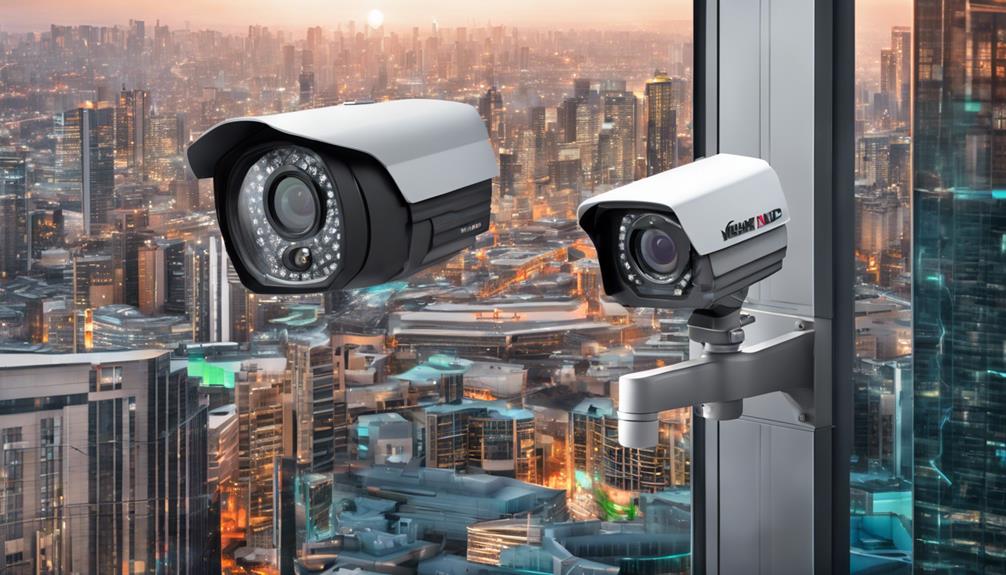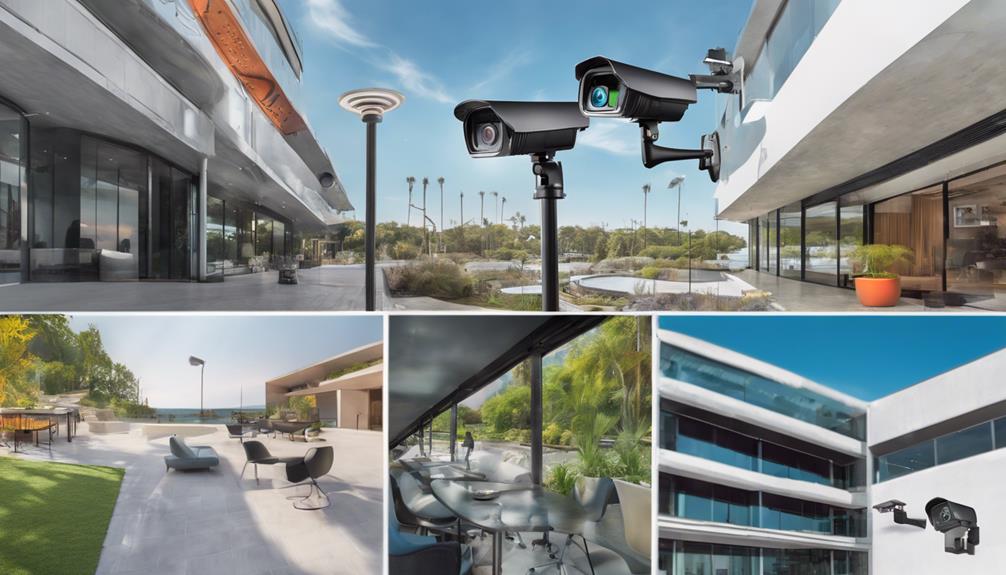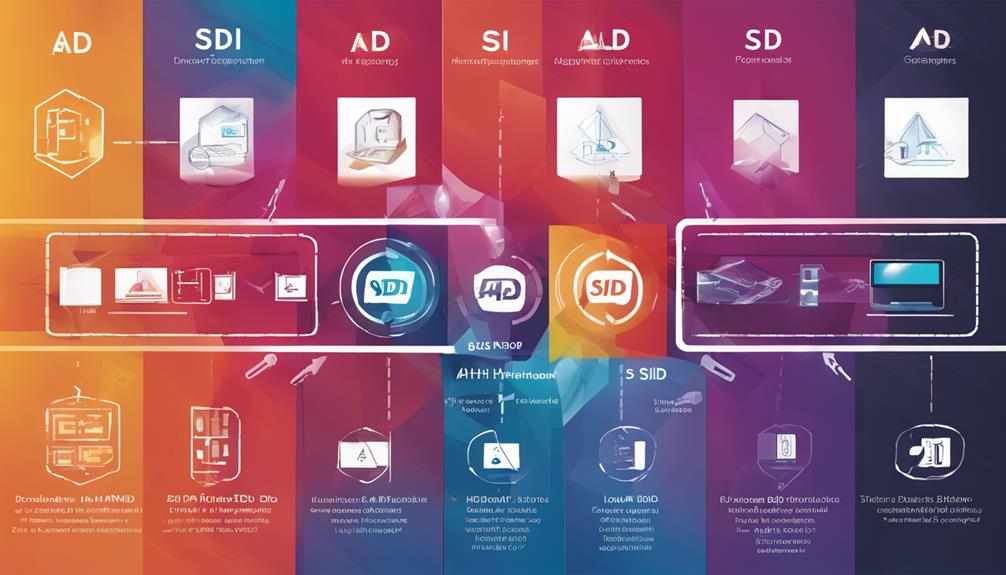When you’re deciding between AHD and SDI, consider your specific needs. AHD offers resolutions up to 1080p and is a cost-effective solution, easy to install using existing coaxial cables. It works well over longer distances without much quality loss. In contrast, SDI supports higher resolutions, up to 4K, and transmits digital signals, ensuring peak performance in professional setups. However, it can require more expensive cables and equipment. Both have their strengths, so understanding your project requirements and existing infrastructure is key. There’s a lot more to explore about these technologies and their applications.
Overview of AHD Technology

AHD, or Analog High Definition, technology provides a significant upgrade over traditional analog systems, offering resolutions up to 1080p. This means you can enjoy a clearer, sharper image, enhancing your viewing experience whether you’re monitoring security footage or enjoying your favorite shows. AHD applications are versatile, making it ideal for both residential and commercial use.
One of the key AHD benefits is its ability to transmit high-definition video over existing coaxial cables, which saves you from the hassle of rewiring your entire setup. You’ll find it particularly useful in security systems, where clarity is essential for identifying details. Furthermore, AHD systems often come at a lower cost compared to digital systems, allowing you to achieve high-quality results without breaking the bank.
Another advantage is that AHD technology supports longer cable runs, providing flexibility in installation. You can position cameras farther away without sacrificing video quality. If you’re looking for a reliable, cost-effective solution that keeps your need for freedom in mind, AHD technology could be just what you need to enhance your video surveillance or entertainment setup. Embracing AHD means enjoying freedom from outdated analog limitations.
Overview of SDI Technology
SDI technology, or Serial Digital Interface, is renowned for its ability to transmit uncompressed, high-definition video signals over long distances without degradation. This makes it a go-to choice for professionals in broadcasting, live events, and other media applications. You’ll find SDI commonly used in studio environments, where maintaining signal integrity is vital.
One of the key aspects of SDI is its adherence to various SDI standards. These standards guarantee compatibility between devices, making it easier for you to integrate different equipment in your workflow. For instance, SDI supports resolutions from standard definition all the way up to 4K and beyond, depending on the specific standard used.
When you’re considering SDI applications, think about situations where high-quality video transmission is indispensable. Whether you’re working with cameras, switches, or video servers, SDI provides a reliable solution. It’s also worth noting that SDI can transmit audio alongside video, simplifying your setup.
Key Differences Between AHD and SDI

When comparing AHD and SDI, it’s crucial to look at their signal transmission methods and video quality. AHD uses coaxial cables to transmit data, while SDI operates over a variety of connections. Understanding these differences can help you choose the right technology for your needs.
Signal Transmission Methods
Choosing the right signal transmission method can considerably impact the performance of your video surveillance system. When considering AHD and SDI, you’ll find they utilize different approaches to transmit data. AHD primarily transmits analog signals, while SDI relies on digital signals. This fundamental difference affects signal integrity and overall system reliability.
In terms of cable specifications, AHD can work with standard coaxial cables, which makes installation easier and often more cost-effective. However, you might face compatibility issues when integrating older equipment. Conversely, SDI typically requires higher-grade cables to maintain signal integrity over longer transmission distances, which can present installation challenges and higher equipment requirements.
Both systems can suffer from signal degradation and noise interference, but SDI usually offers better resistance to these issues due to its digital nature. If you’re dealing with extensive wiring setups, consider that AHD can often perform well over longer distances without significant loss, while SDI may need signal boosters to maintain quality.
Ultimately, your choice will depend on your specific needs, budget, and the existing infrastructure. By weighing these factors, you can select the most suitable signal transmission method for your surveillance system.
Video Quality Comparison
Understanding the differences in video quality between AHD and SDI is fundamental for making an informed decision about your surveillance system. Both technologies have their strengths and limitations, impacting your overall video experience.
Here are some key differences to take into account:
- Resolution: AHD cameras typically offer resolutions up to 1080p, while SDI can support higher resolutions like 4K, providing clearer and more detailed images.
- Distance: AHD limitations come into play when transmitting over long distances, as video quality can degrade over coaxial cables. In contrast, SDI is designed for long-distance transmission without losing quality, making it more reliable for larger setups.
- Compatibility: When integrating systems, SDI compatibility with existing infrastructure can be significant. AHD may have limitations with older equipment, which could necessitate additional upgrades.
Advantages of AHD
When considering AHD, you’ll find several key advantages that make it an attractive choice. It offers high-definition video quality, ensuring clear and detailed images. Plus, it’s a cost-effective solution with an easy installation process, making it accessible for both beginners and professionals.
High-Definition Video Quality
In the domain of video surveillance, AHD (Analog High Definition) technology stands out for its impressive high-definition video quality. If you’re looking for a solution that delivers exceptional clarity, AHD is a strong contender. Its high-definition capabilities not only enhance image sharpness but also improve color depth, allowing you to capture vivid details in your surveillance footage.
Here are three key advantages of AHD’s high-definition video quality:
- Enhanced Clarity: AHD can provide resolutions up to 1080p, ensuring that every detail is crystal clear, making it easier to identify subjects.
- Improved Color Depth: With AHD, you get a broader range of colors, which helps in accurately capturing the scene, even in varying lighting conditions.
- Higher Frame Rates: AHD systems typically support higher frame rates, resulting in smoother video playback, which is essential for tracking fast-moving objects.
Cost-Effective Solution
AHD not only excels in high-definition video quality but also offers a cost-effective solution for your surveillance needs. When you’re considering options, budget considerations often play a considerable role in your decision-making. AHD systems typically come at a lower initial cost compared to other high-definition formats, making them an attractive choice for those looking to maximize their investment.
Moreover, AHD technology provides long-term savings. With its ability to transmit video over existing coaxial cables, you won’t need to invest in new wiring, which can considerably cut down on installation expenses. This compatibility can save you time and money, allowing you to allocate funds elsewhere.
Additionally, AHD cameras generally have lower maintenance costs. Their robust design and longevity mean fewer replacements and repairs, which translates to further savings down the line. By choosing AHD, you’re not just opting for a high-quality surveillance solution; you’re also making a smart financial decision that supports your budget and future needs. Ultimately, AHD empowers you to achieve high-definition surveillance without breaking the bank, giving you freedom and peace of mind.
Easy Installation Process
Because AHD systems are designed for simplicity, you’ll find that the installation process is straightforward and hassle-free. Unlike other surveillance systems, AHD minimizes installation challenges, making it accessible even for those who aren’t tech-savvy. You can enjoy user-friendly features that streamline the setup, allowing you to focus more on enjoying your freedom rather than getting bogged down in complicated wiring or configurations.
Here are three key advantages of the AHD installation process:
- Plug and Play: The AHD system often requires minimal configuration, allowing you to connect and start using it quickly.
- Compatibility: AHD cameras are compatible with existing coaxial cables, which means you won’t need to replace your entire wiring system.
- Clear Instructions: Most AHD systems come with clear, concise installation guides that make the setup easy to follow, reducing the likelihood of errors.
With these benefits, you can rest easy knowing that setting up your AHD system won’t be an intimidating task. Focus on what matters most—security and peace of mind—without the usual headaches of installation.
Advantages of SDI

Many users appreciate the advantages of SDI (Serial Digital Interface) for its ability to deliver high-quality video signals over long distances without significant degradation. One of the standout benefits is its scalability options, allowing you to expand your system easily as your needs grow. Whether you’re working on small projects or large-scale productions, SDI can adapt to various setups, guaranteeing you’re not limited by your initial configuration.
Additionally, SDI minimizes compatibility issues often faced with other interfaces. Since it adheres to established standards, you’re less likely to encounter problems when integrating different equipment. This reliability means you can focus on your creative work rather than troubleshooting signal issues.
Moreover, the robust nature of SDI cables offers superior performance in various environments, making them ideal for professional settings. Their ability to transmit uncompressed video signals ensures that you get the best quality possible.
Choosing the Right System
Choosing the right system for your video production needs can greatly impact your project’s success. Whether you’re leaning towards AHD or SDI, understanding system compatibility and user preferences is vital. Here are three key factors to evaluate:
- Project Requirements: Assess the specific demands of your project. Do you need high-resolution output or long-distance transmission? Identifying these needs helps narrow your choices.
- Equipment Compatibility: Confirm the system you choose works seamlessly with your existing gear. Check if your cameras, monitors, and switches support AHD or SDI to avoid costly upgrades or compatibility issues down the road.
- Ease of Use: User preferences matter, especially in a fast-paced environment. Some systems may offer a more intuitive interface or better support for real-time adjustments. Reflect on your team’s familiarity with either system, as this can affect workflow efficiency.
Frequently Asked Questions
Can AHD and SDI Be Used Together in One System?
Yes, you can integrate AHD and SDI in one system, but guarantee AHD compatibility with your devices. Using both formats allows flexibility, giving you the freedom to choose the best solution for your needs.
What Cable Types Are Compatible With AHD and Sdi?
When choosing cable types, make certain they meet the necessary cable specifications for both formats. Coaxial cables often provide ideal signal integrity, allowing you to enjoy clear video without worrying about compatibility issues or loss of quality.
How Do AHD and SDI Perform in Low-Light Conditions?
In low-light conditions, you’ll find AHD performance shines with decent clarity, while SDI performance excels, delivering superior detail. Both technologies have their strengths, but SDI often offers an edge in darker environments.
Are There Any Licensing Fees for Using AHD or Sdi?
When using AHD, you typically won’t encounter licensing fees, which is one of its advantages. However, with SDI, there may be potential drawbacks, including additional costs that could impact your budget. Consider your options carefully.
What Are the Common Applications for AHD and SDI Systems?
When considering video transmission options, you’ll find AHD advantages in affordability and ease of use, while SDI benefits include superior quality and longer distances. Both systems serve diverse applications in surveillance and broadcasting.



